Speech Economic Performance and Issues in 2001

Glenn Stevens
Assistant Governor, Economic
Australian Industry Group 2001 Forum
Sydney –
I would like to thank the AIG for the invitation to take part in this conference.
We have had a presentation today on the US economy, so you are already acquainted with some of the major issues there. I will, nonetheless, begin with remarks about the international scene. I will then take up a theme that was a feature of our recent Statement on Monetary Policy, namely certain key differences between the US and Australian situations, particularly insofar as financial conditions are concerned. I would then like to examine some aspects of the nature of the recent slowing in the Australian economy, with a view to helping our understanding of what has been happening. I have no new message to impart beyond that given in the Statement. It should go without saying, but I will state anyway, that I have not come to deliver any particular message about the short-term course of monetary policy.
The International Scene
The world economic and financial scene now looks quite different to a year ago. I recall we met here in February last year, at which time it had become clear that 1999 had turned out to be a better year for global growth than had been anticipated. This was mostly due to the fact that the United States economy was experiencing a surge in growth, at a relatively mature stage of their expansion. This was unexpected because, as of the end of 1998, there had been real concerns about the US and global economies, in the aftermath of the various international events in 1997 and 1998. As things turned out, the US and world economies built momentum through 1999, and by early 2000 forecasters were hastily revising up their estimates of growth in most regions. Financial markets had switched from worrying about global deflation and weak growth, to contemplating the possibility that growth might be strong simultaneously in several regions for the first time in a number of years. Market interest rates had risen, share prices were approaching peaks, international commodity prices had started to lift, and oil prices in particular had increased markedly, from twenty-year lows in 1999.
We now know what was suspected a year ago: 2000 turned out to be a very good year for economic growth around most parts of the world, with the IMF's measure of global GDP rising by something between 4½ and 5 per cent – the strongest pace of growth for ten years. But in contrast to the situation in early 2000, the early weeks of this year have featured a rather marked change in tone in commentary abroad. As is usually the case, the focus has been intensely on the US, the more so on this occasion because of the intense debate about ‘new economy’ elements of the US story in recent years. The ebullience in US asset markets cooled during the second half of 2000. Growth in the economy slowed, with a marked slowing or even outright downturn in production in some of the ‘old-fashioned’ sectors of the US economy, like automobiles. One noted and rather influential forecaster has offered the view that overall growth may have ‘stalled’ for a brief period around the turn of the year. Hence the prognosis for the US economy in 2001 is for a markedly weaker economic performance than was envisaged a few months ago.
How much weaker remains, of course, the big question. The Federal Reserve has lowered short-term interest rates by 100 basis points in a month – an action they describe as a ‘rapid and forceful response’ of monetary policy both to the changing circumstances and the changing behaviour of the US economy. This action, together with the decline in interest rates across the yield curve in the US, will help to contain the dampening forces at work in the US economy as the year goes on. There are some signs of lower interest rates affecting the housing sector, and a few other bits of data which suggest that the US economy did not keep weakening early in the new year to the extent that it was in the last few months of 2000. The prospects of a substantial cut in income tax over the medium term should also be kept in mind. Nonetheless, it seems fairly clear that the US economy is at its weakest for a decade, and it is too early to be able to say with confidence which way things will move in the short term.
Meanwhile, there are renewed concerns over the strength of the tentative upswing that began last year in Japan. It appears that economic activity there weakened again in the second half of 2000, after a promising start to the year. The contribution from Japan to global growth in 2001 is increasingly looking as though it will be little different to what it has been for most of the past decade. So things are no worse, but with the US weaker, some acceleration in Japan would have been welcome at this time. Elsewhere in Asia, growth is in the process of softening as the rapid expansion in electronics exports in recent years eases back. This is important: over half of the growth in industrial output in countries like Korea, Taiwan, Singapore, and Malaysia since the 1997 crisis has been in the electronics area. So a slowdown in global demand for such products would be likely to have a noticeable impact.
In Europe, happily, any slowing in growth appears to be fairly mild at present. If 2001 turned out to be a year in which Europe was the world economy's strongest major region, it would be a remarkable change from the position in the past five or more years.
Overall, the consensus of international forecasters at present seems to be that global growth in 2001 could be something more like its long-run average of about 3½ per cent, or a little less. This is a substantial reduction on the 2000 result, and noticeably below what was expected only a few months ago, although still a respectable outcome. Whether or not these sorts of forecasts have fully taken on board the implications of the slower US economy for various exporters in Asia and Europe, and then all the later round impacts of that and so on – is not clear. It must still be conceded, as Fed Chairman Greenspan did recently, that there are downside risks to the US outlook at this stage. So it may still be that these aggregate world growth forecasts will fall some more.
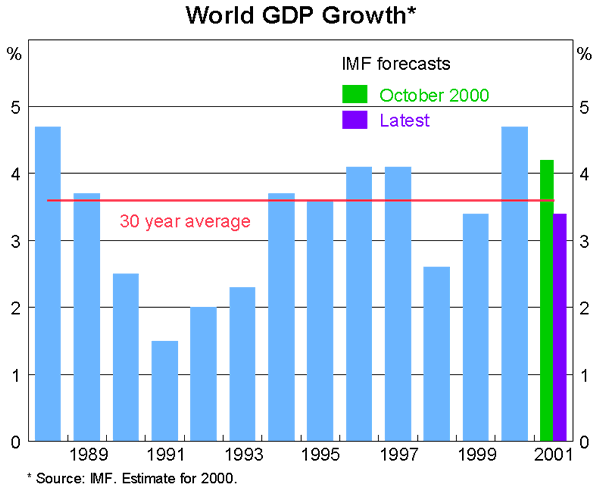
However, it is worth recalling that pessimism can be overdone. In a way that is the point of going through some of the history of recent years as I did earlier: in late 1998, most people thought things looked pretty grim. But events turned out much better than expected. Some of the forces at work in producing the slowing in 2000 – such as higher market and official interest rates and rising oil prices – are either no longer exerting the same degree of influence or have reversed direction. So while I think most people would still be worried about risks to the downside in the short term, we could spare a thought for the possibility that the world economy could get by in reasonable shape this year, and that 2002 might turn out to be a pretty good year.
All of this means that the international environment for Australia is changing, in a couple of important respects. First, obviously, it is unlikely to be quite as easy to grow export sales in a world of 3 to 3½ per cent global growth, if that is what we are facing, as in a 4½ to 5 per cent world. But that must be kept in perspective. The gains in export incomes we have seen recently have been extraordinary. Between the June quarter of 1999 and the December quarter of 2000, export values rose by nearly 45 per cent, or nearly 5 percentage points of GDP – in a period of eighteen months. A good part of this was higher prices, due in some measure to the lower exchange rate and also higher international prices. Part was also due to growth in volumes, in some instances due to resource projects coming on stream as a result of large previous investments.
That sort of growth rarely continues at the same pace no matter how favourable the conditions. Forecasters have had some moderation in mind all along, and when we see it we should remember that much of it is just coming off the exceptional strength of the recent past. At the same time, the current level of the exchange rate represents a big shift in relative prices, which should provide substantial ongoing assistance for the export sector (and the import-competing sector). This ought to mean that unless there is a very severe slowdown in the world economy, the trade sector of the economy should still do pretty well, even if the growth rates are not quite as high as in the past year.
Second, the strength of capital flows to the US, which were at the expense of the potential uses for capital elsewhere, including Australia, would be expected to be less pronounced. This is something that has not been much remarked on, but it is important. Continuation of the degree of gravitational force exerted on global capital by the US in the past couple of years would most likely have meant ongoing adjustment issues for other countries who, like Australia, have internationally open capital markets. These adjustments, which find their expression partly in shifts in exchange rates, can be difficult to cope with. Hence some cooling in the US demand for capital from abroad is perhaps to be welcomed – without that meaning that an abrupt disruption in US markets could be viewed as benign.
What are the Similarities and Differences Between Australia and the United States?
There have been some obvious similarities between Australian and US economic performances in the past, and at a superficial level, some of these persist now. Both economies have slowed, after an extended period of exceptionally strong growth. In both cases, the extent of this slowing has been more pronounced just lately than had been expected, particularly in the closing months of last year. Both have been affected by the impact on household spending power of higher oil prices, a modest rise in interest rates, and slower gains in wealth than had occurred earlier. Beneath the surface, however, there are some differences which are important. Our recent Statement pointed some of these out and I would like to highlight a few.
(a) Availability and price of credit
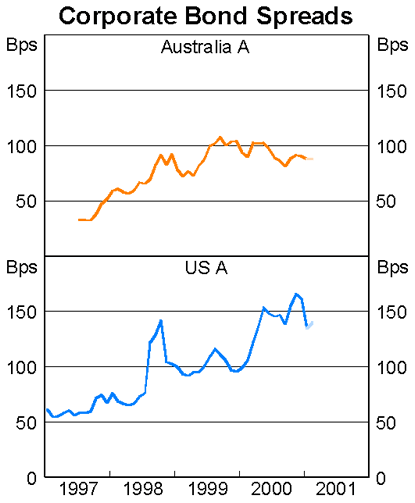
During 2000 there was a noticeable change in the way risk was priced in US debt markets. This is clearly evident in the increase in spreads between yields on US Treasury securities and those on corporate bonds. Now this was affected to some extent by the prospect of a decline in the supply of Government bonds in the future, a result of the expected budget position of the US government, which has pushed down government bond yields. It is also important to note that the absolute level of investment-grade corporate bond yields in the US peaked as far back as the middle of 2000, and has declined since. So we do not want to make too much of this point. The spreads themselves have also declined since early January, in apparent response to the confidence boost arising from the easing in US monetary policy. Nonetheless, there was a clear change in the willingness of markets to accept risk during 2000. For lesser-quality borrowers in particular, this was quite pronounced. Consistent with this shift, there have been reports that the flow of funds into the corporate sector via the debt and equity markets slowed abruptly towards the end of 2000. There were also signs that in the second half of last year, the terms at which loans were offered by banks began to tighten independently of the price. The evidence for this comes from a survey conducted by the Federal Reserve of loan officers at a large number of commercial banks.
So I think it is a reasonable assessment that accessing both the capital markets and intermediaries for funds became noticeably more difficult and more costly for US firms in 2000. I would not want to venture an opinion on just how binding a constraint this will be over time, or whether it will persist. It may even now be easing. The point is simply that the direction of change, during last year, was fairly clear.
What has been the situation in Australia? We can observe that there was no noticeable widening in risk spreads in the corporate bond market over the past year. There was some widening in 1998, as there was elsewhere, but since then no discernible trend. We can also observe that funds have continued to flow into the corporate sector, after a brief hiatus associated with the Olympics period.
Of course, in Australia the flow of credit via intermediaries is more important than in the US (though not quite as important as it was in years past). Our figures on business credit growth have been characterised by a noticeable degree of volatility over the past two years. Overall, there appears to have been some decline in credit growth, but not to an extent that could be seen as signifying any serious problem in credit availability. There is at this point no significant rise in loan arrears, and no reports of significant changes in bank's lending attitudes.
On this comparison, the degree of concern which might be held about the possibility of credit market disruptions to the US economy does not appear to carry over to the Australian case.
(b) Asset markets
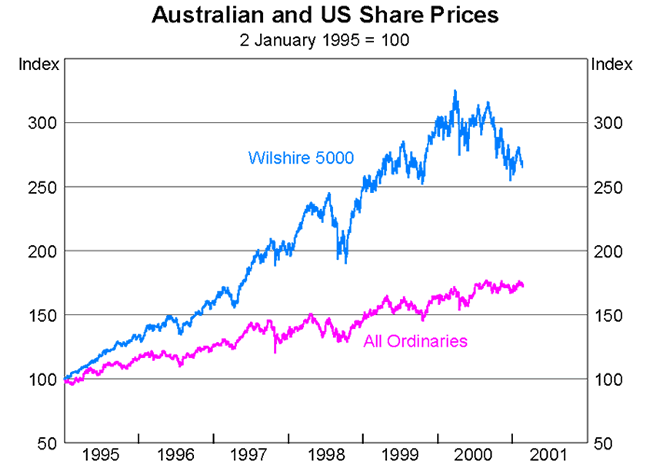
The asset market which has attracted most attention for the past several years is, of course, the share market, and the US share market in particular. The accompanying chart shows a comparison of the broadly-based share indexes for Australia and for the US. The Australian share market has risen by about 50 per cent, in local currency terms, since the beginning of 1995. The US market rose 200 per cent up to about March last year, but then fell back by 15 per cent or so, whereas the Australian market has remained close to the peak – a more modest peak reached after a much more gradual appreciation than seen in the US.
A year ago, amidst talk of the new economy, the technology boom and so on, this comparison might perhaps have been used as evidence for the Australian economy's lack of dynamism. If concerns today are more about possible fragilities in markets where prices have risen a lot, such concerns should be less pronounced in Australia.
(c) Exchange rate
It is worth returning to exchange rates to make the case that here is another difference between Australia and the US. A simple comparison of the real effective exchange rate for the two currencies makes the point fairly clear. The US dollar has appreciated noticeably over recent years. It is not as high as it was in the mid 1980s, but a fairly substantial and rather sustained appreciation over recent years is nonetheless apparent.
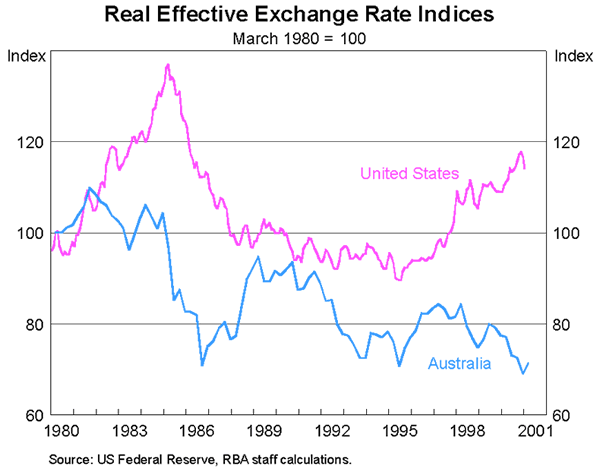
The Australian dollar, in contrast, has been as low in real effective terms in recent months as at any time in our modern history. There has been much debate about why that has been so and the Bank has had some views to offer. I don't wish to add to that today. I simply want to argue that this is a matter of great importance for those engaged in the trade sector of the economy. When the exchange rate moves, there are gainers and losers. Those using imported inputs are clearly bearing the burden of a rise in costs. This is surely a big part of what lies behind the claim that, in some sectors at least, there is a squeeze on profit margins. In some cases, the losses may also be borne by foreign suppliers, if they price to the Australian market and therefore have to reduce the price they get in foreign currency terms when the Australian dollar falls.
The gainers in this process are basically all the domestic factors of production – domestically-produced inputs, raw materials, services, labour – whose value added can now be supplied more competitively with those from abroad, without them needing to have reduced their price in Australian dollar terms. If the exchange rate remains near recent levels, this should be a powerful medium-term force in favour of expanding the output of the trade sector of the economy.
(d) Investment
A final comparison is business investment. A feature of the US economy in recent years has been the strength of investment, especially in information technology and communications equipment. As a share of GDP, this type of investment surged in the past couple of years in particular. The capacity to produce this equipment also expanded rapidly – by 50 per cent in the past year alone, according to estimates quoted by Fed Chairman Greenspan recently. Some observers are talking of this as over-investment. While it is difficult to know, especially given the very high rates of depreciation of such equipment, it can be observed that the share of overall investment in US GDP reached historically high levels in 2000.
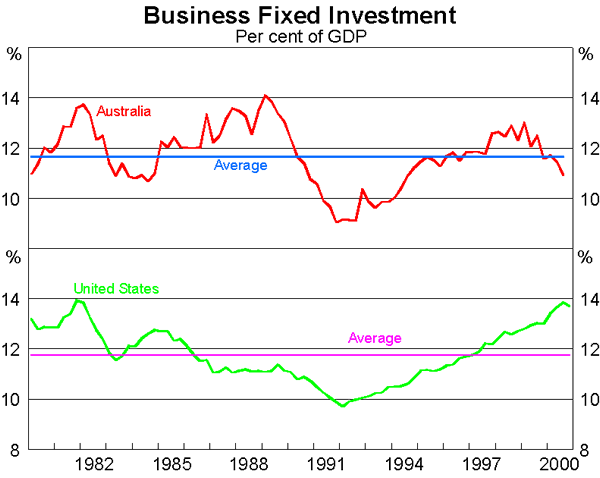
In Australia, in contrast, business investment as a share of GDP has been declining for the past two years or so. The share of ITC-type investment has been increasing, but only in a way that would be consistent with long-term trends, and without the recent surge seen in the United States. There is no sense of serious over investment. Since, as we are often reminded, the Australian economy does not have a major sector involved in producing IT equipment, we can be confident that we do not have a problem of over-capacity in that sector. If there is over-capacity abroad, we are likely to reap the benefits of falling prices for ITC equipment.
So my overall conclusion is that there are some important differences at work in the Australian economy, when compared with those in the US. This is not to deny that the US outcomes are very important, nor does it mean Australia is guaranteed a problem-free ride if the US economy continues to find heavy going. A weaker US economy itself would be a factor that would surely, other things equal, change one's view of the outlook for Australia. But the absence of serious problems in these areas means we are better placed to cope with whatever might come along than we would otherwise have been.
Why has the Australian Economy Suddenly Looked Weaker Just Lately?
This still leaves a question about why it is that the Australian economy is looking softer than had generally been expected, particularly in the latter months of 2000.
No doubt many factors have been at work. One thing I would like to point to in particular, however, is the dynamics associated with the construction sector, because they have been quite important.
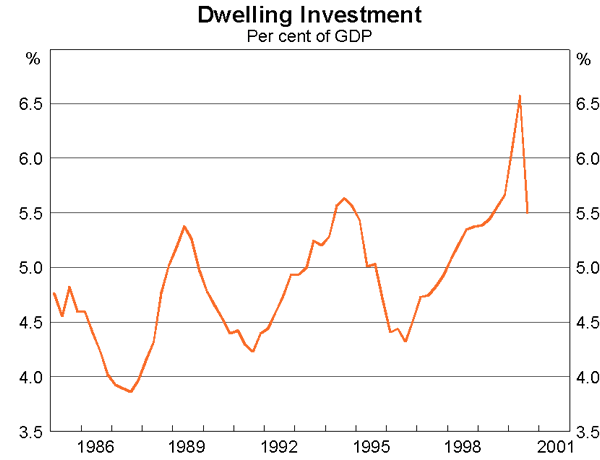
The essential facts are that activity in constructing and renovating dwellings reached an extreme peak in the June quarter, as people attempted to get work in ahead of the impending introduction of the GST. That such a pattern would occur was always understood, but its strength was remarkable. Then in the second half of the year, this activity fell away very sharply. In fact according to the national income accounts, the fall in dwelling investment in the September quarter was the largest recorded in the forty years for which we have that data set. The ‘bring forward’ activity simply borrowed work from the 2000/01 year and brought it into the 1999/2000 financial year. So that had to be ‘paid back’. Note that I am not saying that the GST has damaged the housing sector, only that it caused a timing impact on spending. There is no reason to expect the combined upward and downward legs of the pattern in the past year to lead to any sustained net loss of activity.
Once the height of the June peak had been observed, it was obvious that a pretty big decline was in prospect. But what was a surprise was that such a large part of that adjustment occurred in one quarter, rather than being spread over three or four quarters.
House construction activity feeds into several areas of the manufacturing sector, of course, so the abrupt downturn in housing was quickly reflected in the output of some of those areas. The combined effect seems to have had quite a big impact in the labour market. The following chart shows the cumulative movements in employment over the past year.[1]
Between late 1999 and the middle of 2000, there was a very strong rise in employment, as everyone knows. The chart shows how much of this was accounted for by the construction sector, and some more in sectors of manufacturing which supply construction. If anything, the contribution is surprisingly small given the strength in construction activity at the time, though there had been a substantial pick-up in construction employment during 1999. But between August and November last year, these two sectors recorded a decline in employment of about 60,000, which compares with a recorded fall in total employment of about 95,000 over that period. So it seems reasonable to conclude that a significant part, though not all, of the weakening in employment in the latter part of 2000 was concentrated in the areas most directly affected by the construction sector. Some corroborating evidence for this exists in the newspaper-based data on job vacancies that appear to have been heavily influenced by falls in construction job openings.[2]
It appears also that the response of employment to the decline in activity has been faster than it has been with other cyclical turning points. This could be because the turning point itself was widely anticipated, even if the subsequent speed of the decline was not. The flip side of this is that accelerating the period of adjustment also means, of course, that the sectors concerned can return more quickly to a more normal equilibrium, and it is reasonable to expect that this process will begin as the year proceeds. Indeed, the key leading indicators for the sector – lending approvals and building approvals – have already turned up.
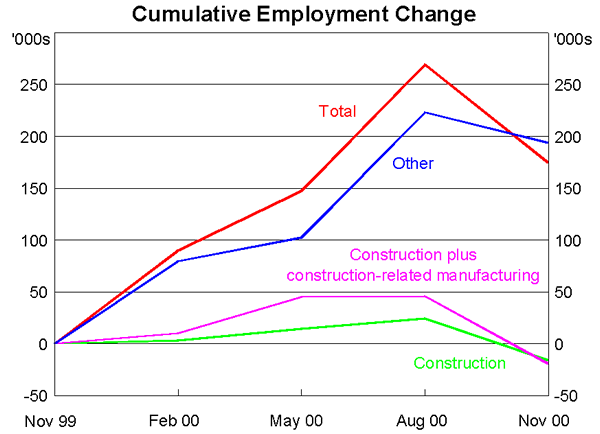
Employment in other sectors did record a fall in total during this same period, and so we cannot claim that all the observed weakness is the outworking of the cycle in construction. This, among other data, is what prompted us to say in recent statements that, underlying the obviously large fluctuations driven by temporary factors, the economy looked a bit weaker than it did a while back.
Candidates to explain those trends would include the general macro factors used earlier. On top of these, the rise in raw materials costs, and transitional costs associated with changes to the tax system, are factors that may have had some bearing on businesses' perceptions of trading conditions. The relative weight of these potential factors can't be determined with any precision. In fact, it is the conjunction of all of them which is probably the key thing.
Conclusion
There is more that could be said about the Australian economy and its prospects. For the Bank's views, I would refer you to the recent Statement. And, of course, we have had some excellent presentations here today. Hopefully our understanding of what has been happening and why has been improved a little, which should help in forming sensible expectations and strategies for the year ahead. I wish you every success.
Endnotes
The data are quarterly, taken from the mid-month of the quarter labour force survey, since I want to break down the figures by industry. Hence the latest observation is November 2000. According to the monthly labour force data, employment rose by 40,000 in December, and was little changed in January. We cannot know at present how that pattern was distributed across industries. The‘construction related manufacturing’ sectors are those producing wood and paper products, non metallic mineral products and metal products. This definition is based on observed relationships between output in these sectors and construction expenditure in the past. Of course, not all the output of these sectors would go into construction, which would mean that the employment reduction assigned to construction here would be overstated. At the same time, other sectors not included here may sell a small part of their output into the construction sector, biasing the estimate in the other direction. The data were seasonally adjusted by RBA staff using X-11. [1]
I should flag here that this pattern does not show in the ABS measure of vacancies, which overall are much stronger than the newspaper series. [2]